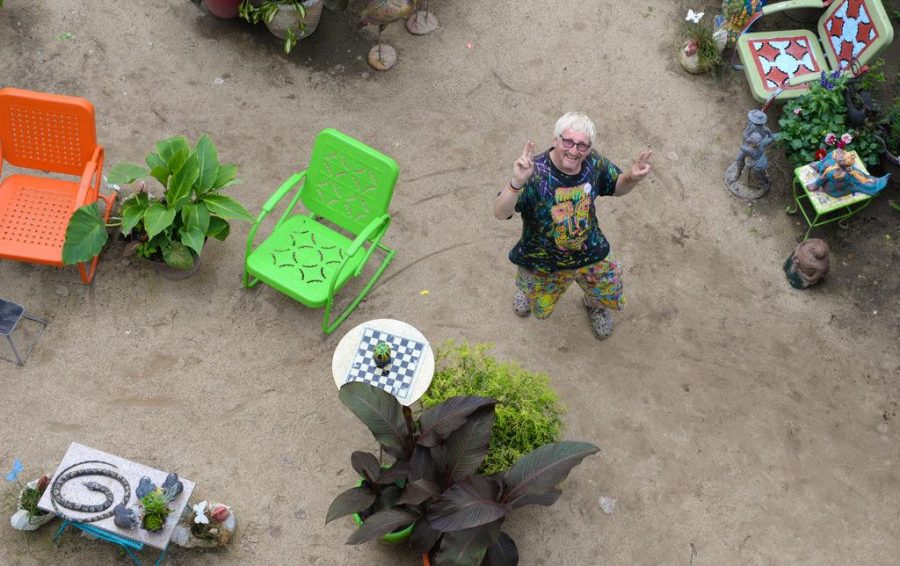Walking down Jacksonia Street in Pittsburgh’s Northside, a bright yellow house greets visitors from the corner of Arch Street. Sporting giant artificial butterflies, larger-than-life Coca-Cola bottle caps and dozens of potted plants scattered across the sidewalk, Randyland is a beacon of explosive creativity in an otherwise ordinary neighborhood.
The colorful museum sits in the backyard of Northside resident Randy Gilson’s property. Decorated like a castle, the “hands-on” locale opened in 1998. Gilson funds Randyland mostly through tips from his day job as a waiter, with a small percentage of its upkeep coming from visitor donations.
The free museum, which sees about 200 visitors a day, is located at 1501 Arch St. It features an eclectic assortment of recycled toys, plastic buckets and shovels on a sand floor meant to evoke images of the beach. Artwork that Gilson painted himself is also a staple.
Gilson greets visitors to the museum with an emphatic “hello” and a handshake, and he encourages them to play with the art and move pieces around.
While Randyland is a technicolor home of reclaimed art, this whimsical mecca started from tragic beginnings.
Despite his reputation as one of Pittsburgh’s most influential artists, Gilson, 58, did not discover art until much later in life. His childhood was a tumultuous one — his parents were ministers in the Salvation Army who went on to have six kids, including Randy. When he was nine years old, his mother took custody of him and his siblings and left for Homestead, where they received support from welfare and bounced between temporary homes.
Gilson’ mother could only afford to provide her children with basic necessities, so they spent many Christmases sitting on the barren cold floor around a presentless tree.
“We started school the day after Christmas,” Gilson said. “And the children were asking, ‘What did you get?’ We got nothing, because we were so poor.”
The next year, however, Gilson found old toys in his neighbors’ garbage cans. He washed and repaired them, and put them under the Christmas tree for his brothers and sisters. Since then, Gilson has collected almost everything he comes across, whether it’s toys, old furniture or even paint.
“My suffering was actually my education,” Gilson said.
Gilson moved to the Northside as an adult in the 1980s and noticed the vacant lots, lack of color and strewn-out garbage that plagued his new neighborhood. He took it upon himself to clean up the area, using materials left over from properties that the city was tearing down to build new walkways. He taught himself to garden and replaced the weed-covered lots with more attractive shrubbery and flowery, eventually starting The Old Allegheny Garden Society in the early 1980s. The organization, which Gilson has released control of, has now planted 40 more community gardens in Allegheny County.
He bought Randyland as his home in 1995, when the community was scheduled to destroy the then-dilapidated house. Soon, he began painting it with bright yellows, blues and purples. He decorated the outside with potted plants in painted vases, recycled toys and sculptures of angels, rats, lions and butterflies. Nearly every inch of the backyard is filled with recycled goods, making it almost impossible to truly take in everything in one visit.
“I call Randyland a scattered museum,” Gilson said. “It’s just a collection of scattered stuff.”
Marsha Korshik, a Sheraden resident, has visited Randyland four or five times in the last couple months. She treats each new visit like a game of “Spot the Difference.”
“Every time I come, something is different,” Korshik said. “Nothing looks the same twice.”
There is an equal abundance of art painted by Gilson himself. At the entrance, an elaborate and colorful mural of the Northside greets visitors, featuring cut-outs of 3-D houses, people and trees glued along the painted streets.
Gilson refers to himself as a “self-taught” artist, which is even more impressive when one sees the intricate art all around the park: a mosaic of a winding river in the mountains and black shadow people between theater-like curtains on the walls of his home.
Aside from the art, Gilson’s seemingly endless energy and positivity attracts people to him. His personality has even made him the subject of an upcoming documentary by Pittsburgh filmmaker Sean McKeag.
Josh Freyermuth wandered into the park a little over a month ago, after relationship troubles had him feeling depressed. He walked into Randyland on a whim and said he was overwhelmed by its positive energy. He became fast friends with Gilson, who soon offered him a job painting in the museum.
Monica Colberg, a first-time visitor to Randyland, walked away with a similarly profound impression.
“Randyland is [Gilson’s] way of loving the world,” Colberg said.
Although rumors have begun swirling about Gilson selling Randyland, he emphatically denies that will ever be the case.
He is, however, working to establish the park as a trust over the next two or three years to relieve himself of some of its demanding responsibilities. He hopes to build a board of trustees to oversee the park’s management, and allow organizations like City of Asylum and Carnegie Museum of Art to use the space to host events.
For Gilson, the most important part is that Randyland remains open to the public.
“Randyland could never be owned by anybody, ever,” said Gilson. “[Randyland] is the smiles that people give me, the hugs and the handshakes, the conversation. Randyland belongs to everybody.”


